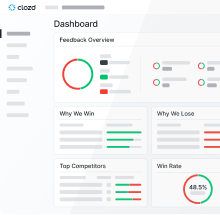Product-market fit (PMF) is the gold standard for any B2B company aiming to drive sustainable revenue and outpace the competition. For startups and scaling organizations alike, PMF signals that what you're building actually matches what the market demands—right now. But achieving PMF is not a box to check; it's an evolving target that requires continuous feedback, rigorous measurement, and relentless adaptation. GTM leaders—from product marketing to sales enablement—need more than surface-level customer data. Authentic buyer feedback is the backbone of real product-market fit, powering revenue growth, sharper positioning, and smarter product decisions.
This guide offers a practical, executive lens on PMF. You'll get a clear PMF definition, actionable frameworks, specific metrics, tangible stages, and the warning signs to watch out for if you're off track. Most importantly, we’ll show you how to sustain PMF using authentic customer feedback—real insights that translate directly into operational and revenue impact.
Definition: What Is Product-Market Fit?
At its core, product-market fit means operating in a “good market with a product that can satisfy that market.” Marc Andreessen’s classic definition is still relevant, but in B2B, it goes further: PMF is dynamic, fluid, and measured by your ability to deliver unmistakable value that customers can’t imagine living without. You'll see this when buyers advocate for your solution, organically refer peers, and speak enthusiastically about the reasons they choose you.
PMF isn’t a binary achievement. An early-stage company might see “problem-solution fit,” while mature GTM organizations focus on repeatable, scalable growth—what we call “scaled PMF.” This customer alignment is always in motion, shaped by market shifts, evolving buyer needs, and competitive moves. Without continuous attention, today’s PMF can evaporate tomorrow.
Beware of vanity metrics. High acquisition doesn’t mean true fit if users don’t stick around. A short-term revenue spike from deep discounts won’t sustain growth. The real signals: high retention, expansion within accounts, referral momentum, and clear customer articulation of your differentiated value. PMF is about solving critical problems so effectively that your customer base feels a genuine loss if your product goes away.
How to Measure Product-Market Fit (Quantitative + Qualitative)
Achieving true PMF requires blending hard data with authentic buyer insights. Overreliance on CRMs alone is risky: Our findings show the closed-lost reason in CRM systems is wrong 85% of the time—and the wrong competitor is tagged 65% of the time. The only genuine source of truth is your buyer.
The Sean Ellis “40% Very Disappointed” Survey
One leading qualitative measure is Sean Ellis’ “40% rule.” If at least 40% of your users would be “very disappointed” if your product was taken away, you’re on the right path. Run a simple survey: “How would you feel if you could no longer use [Product]?” targeting active users. This cut-through-the-noise metric gauges not just satisfaction, but true dependency and product stickiness.
Retention and Expansion Metrics
PMF shines brightest in your retention data. High retention and net revenue retention (NRR) rates mean users stay and expand usage—they’re seeing clear, ongoing value. Closely monitor cohort retention, gross retention, and customer lifetime value (CLTV). A robust NRR signals customers are upgrading, cross-buying, and investing further—proof of real alignment with market needs.
Win-Loss Insights as Leading Indicators
Win-loss analysis is the most actionable leading indicator of PMF. By interviewing both recent buyers and lost prospects, you go beyond guesswork and surface the precise, nuanced reasons behind wins and losses. Authentic buyer conversations uncover the true strengths, gaps, and competitive landscape—insights that can’t be found in your CRM. This is the direct voice of the buyer, helping GTM leaders fine-tune value props, prioritize product features, and adapt positioning in real time. With over 50,000 buyer interviews, we’ve seen firsthand how continuous win-loss analysis becomes the single most effective feedback loop for maintaining and optimizing product-market fit.
Activation & Adoption (Time to Value)
Rapid onboarding and feature activation are strong quantitative signals of PMF. If users reach key outcomes quickly—without friction—they’re more likely to become long-term advocates. Track time-to-value (TTV), daily/weekly active users, and adoption of critical workflows. Delays or confusion in initial usage often signal friction or mismatched value, risking fit.
Referral/Advocacy Signals
Organic advocacy is a hallmark of PMF. Strong Net Promoter Scores (NPS), glowing customer reviews, and an uptick in inbound referrals indicate that users see your product as indispensable. When word-of-mouth starts generating qualified pipeline without additional marketing spend, you’re delivering real, differentiated value that stands out in the market.
The Product-Market Fit Pyramid (Framework Overview)
Dan Olsen’s Product-Market Fit Pyramid is a practical framework for engineering and evaluating PMF. It’s a five-layered model that ensures you’re aligning the product journey with authentic market demand:
- Target Customer: Get granular about who you serve—ICP profiles, segments, roles, industries.
- Underserved Needs: Zero in on acute pains and unaddressed desires your target buyers express (validated by actual feedback, not assumptions).
- Value Proposition: Clearly articulate how your solution uniquely addresses those pains—what’s your bold promise to this audience?
- Feature Set: Identify exactly which capabilities are essential for delivering on your promise. Avoid the trap of building features for features’ sake.
- User Experience (UX): Make sure the product is intuitive, efficient, and a joy to use. If your UX frustrates users, even a killer feature set can’t save you.
Misalignment at any level—especially skipping buyer research, misunderstanding needs, or ignoring UX issues—undermines fit. GTM teams must continuously revisit and test each layer as markets evolve, using a mix of direct buyer interviews, win-loss programs, and segment-level data to ensure sustained product-market fit.
Stages of Product-Market Fit (From Early PMF → Scaling PMF)
Product-market fit is a journey, not a milestone. It evolves through distinct stages, each with unique challenges and success measures. For B2B leaders, understanding these phases is essential to allocate resources, prioritize strategies, and avoid false positives.
Signs You Do Not Have Product-Market Fit
Missing PMF is costly—and the evidence is clear if you know where to look. If you’re seeing these symptoms, it’s time to pause, listen, and adjust:
- High Churn: Customers leave faster than you replace them, indicating lack of ongoing value.
- Sales-Driven Roadmap: Product priorities shift for single big-ticket deals or “squeaky wheels,” rather than a clear pattern in buyer feedback.
- Buyers Can’t Articulate Your Value: Users struggle to describe your unique differentiation or the core problem you solve.
- No-Decision Deals: Large percentages of opportunities stall indefinitely—not lost to a competitor, but because your solution isn’t vitally compelling.
- Discount-Driven Sales: Success hinges on heavy price cuts, not genuine demand—a clear sign you’re patching a weak value story.
- Low Referral/Word-of-Mouth: Pipeline is driven mostly by push marketing and outbound, with few unsolicited referrals or advocacy moments.
When these signals emerge, prioritize real conversations with buyers and lost prospects. The source of truth is not your CRM—it’s what your prospects and customers tell you. Addressing misalignment early saves time, money, and prevents failure to scale.
How to Maintain PMF Over Time
PMF is a moving target. Your solution and your market both change—sometimes abruptly. Ongoing, structured feedback programs are your insurance against becoming obsolete. Our customer feedback and win-loss programs are designed to institutionalize this vigilance.
Quarterly PMF Reviews
Build discipline with quarterly, cross-functional PMF reviews. Bring together product, marketing, sales, CS, and executives. Review retention, adoption, NPS, churn, win rates, and—most critically—fresh win-loss interviews. Identify new customer needs, test for “segment drift,” and pressure-test whether your positioning still fits. These reviews are how you prevent gradual market misalignment.
Continuous Win-Loss Analysis
According to our 2025 State of Win-Loss Analysis Report, 97% of companies performing win-loss analysis plan to maintain or increase investment. Why? Because methodically interviewing wins and losses keeps you tapped into evolving buyer priorities and surfacing threats and opportunities before they become problems. This program is your early warning system—enabling swift course correction and competitive advantage.
Segment Drift Detection
Winning segments change: sometimes your best customer profile migrates, or a new segment emerges with stronger fit. Track win rates, loss patterns, and feedback themes by segment. If you see declining performance in one ICP and rising success in another, that's segment drift in action—requiring an agile realignment of GTM, messaging, and product focus.
Messaging Refreshes
Market stories and customer priorities evolve rapidly. Use real, recent buyer feedback to test and refine positioning every quarter. If win-loss interviews reveal buyers have trouble recalling your value or key differentiators, a messaging reboot is overdue.
Post-Onboarding Feedback Loops
Early customer experience sets the long-term tone. Systematic feedback following onboarding uncovers friction, unmet expectations, or quick wins that can boost adoption. These insights fuel short-cycle product improvements that enhance retention and strengthen PMF.
Examples of Product-Market Fit (Short, Real-World Scenarios)
PMF is best observed in real outcomes and customer behavior changes:
- Slack: Early Slack users demanded adoption across teams, driving viral, organization-wide growth grounded in eliminating communication chaos. Loss deals shifted from “we’re fine with email” to an explicit desire for integrated, asynchronous communication—and Slack became the default.
- Zoom: Well before the pandemic, Zoom was winning on reliability and ease-of-use. Buyers named “ease of use” and “reliability” in interviews as core reasons for choosing Zoom—even when other options were already installed.
- Netflix (Streaming): Netflix's move to streaming instantly resolved pain points around late fees and scarcity. Advocacy and referrals exploded as customers messaged friends about unlimited, instant entertainment—shifting loss patterns from content selection to a new, compelling benefit set.
You see PMF in loyal usage, organic expansion, and buyer narratives that echo your differentiators—pulled directly from authentic customer voices.
FAQ Section
What is a good PMF score?
The “very disappointed” 40% threshold from Sean Ellis is the strongest single qualitative PMF signal. Complement this with low churn rates, strong NRR, and healthy inbound referral volumes for a complete picture.
How often should you measure PMF?
PMF is never “set and forget.” Mix ongoing quantitative tracking (retention, churn) with quarterly win-loss interviews and PMF surveys. Early-stage or evolving companies should aim for even more frequent feedback cycles.
Can you have PMF in one segment and not another?
Absolutely. PMF is often segment-specific. Many companies find strong fit in one ICP or use case but not others. Regular segment-level win-loss analysis helps you double down where fit is strong and adapt or avoid mismatched segments.
How long does it take to reach PMF?
There’s no rule. Some companies achieve fit in months, others spend years iterating. The critical factor is feedback velocity and quality—those who listen, learn, and adapt via authentic buyer feedback reach PMF faster and more reliably.
If you’re ready to fuel revenue with actionable win-loss insights, explore our Definitive Guide to Win-Loss Analysis or connect with our team to see how Clozd can help you build and sustain authentic product-market fit.











.svg)


.png)
.png)







.svg)

.svg)




